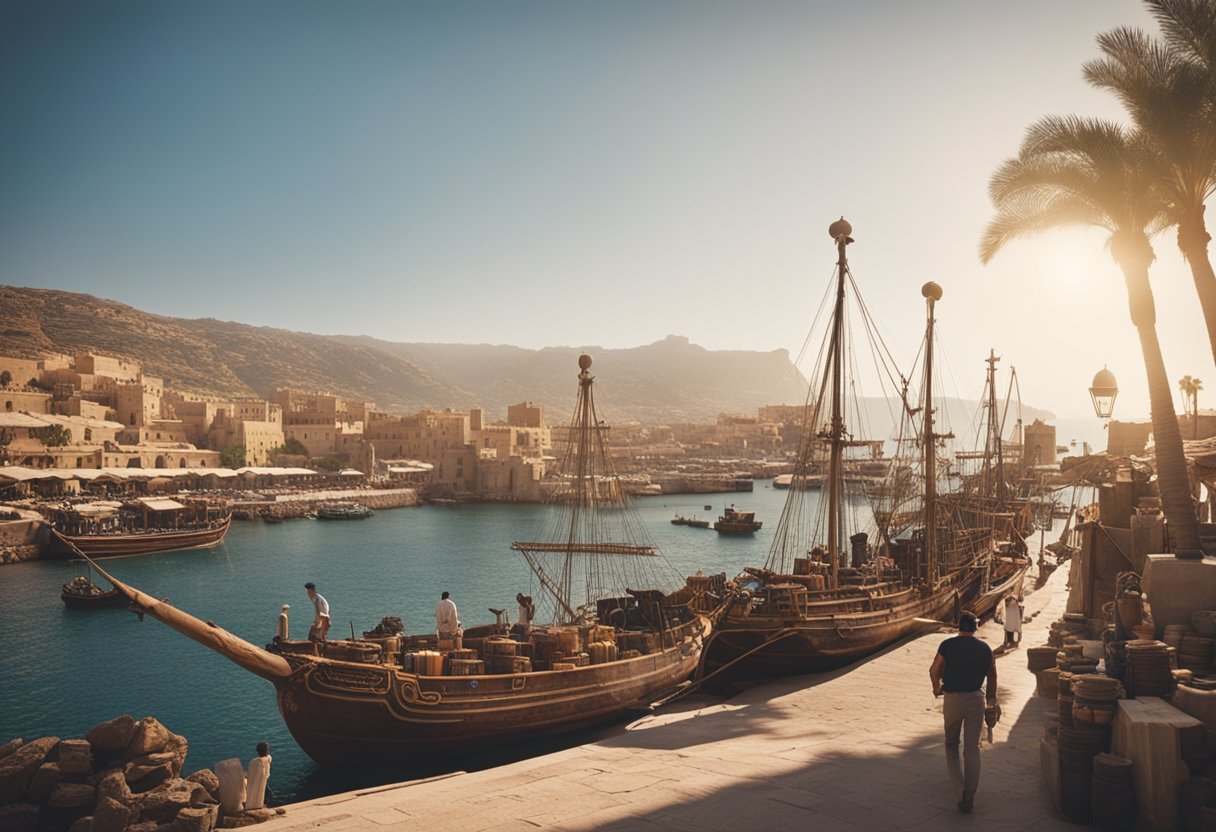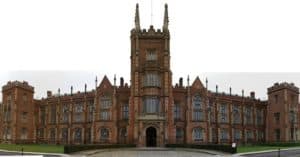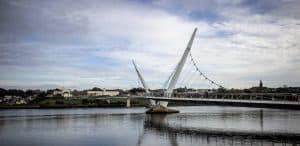The Cultural Legacy of the Phoenicians: Exploration How the Ancient Mariners Shaped Trade and Civilisation

Updated On: April 17, 2024 by Fatma Mohamed
The Phoenicians, a civilisation that emerged in the Eastern Mediterranean around 1500 BCE, left a profound and indelible legacy on the ancient world through their remarkable skills as mariners and traders. Known for their pioneering seafaring abilities, they established an expansive trade network, which became the backbone for their economic dominance and influential cultural exchange. It was through their mastery of the seas and innovative shipbuilding techniques that they connected disparate regions and cultures, laying the groundwork for a rich interchange of ideas, technologies, and commodities.

As adept traders, the Phoenicians not only provided a conduit for material wealth but also facilitated a cross-pollination of artistic and cultural practices. Their strategic establishment of colonies and trading posts across the Mediterranean and beyond served as hubs for cultural interactions with various civilisations. These interactions contributed to the Phoenicians’ diverse and rich religious practices and beliefs, which were integral to their societal framework. Despite their eventual decline, the Phoenicians’ impact resonates through historical and modern accounts, as scholars and enthusiasts continue to retell their story, ensuring their influential role in history is remembered and appreciated.
Table of Contents
Rise of Phoenician Civilisation
The Phoenician civilisation emerged as a dominant maritime force, known for their advanced seafaring skills and extensive trade networks which fostered their cultural and economic growth.
Geographic Origins
The roots of Phoenician civilisation can be traced back to the coastal region of the eastern Mediterranean, particularly in what is now modern Lebanon and parts of Syria. Blessed with a narrow strip of fertile land flanked by the sea on one side and the mountains on the other, our ancestors found opportunities for maritime trade and resource exploitation. This inherent geographical advantage laid the foundation for the Phoenicians to develop a culture heavily centred around seafaring and trade.
City-States and Political Structure
Unlike many of their contemporary civilisations, the Phoenicians organised themselves into independent city-states such as Tyre, Sidon, and Byblos. Each of these city-states operated under its own king and political assemblies but were linked by a shared culture, language, and religious beliefs. The absence of a centralised political structure encouraged fierce competition and innovation amongst the states, which propelled them to build powerful trade empires and establish colonies across the Mediterranean Sea. Our political system was designed to support commerce, reflecting our pragmatic nature and the high value we placed on trade and economic prosperity.
Economic Foundations of Phoenician Dominance

Our analysis of the Phoenicians’ economic prowess reveals that their dominance stemmed from an intricate tapestry of trade networks and the strategic exports of key resources. They leveraged their position along the Mediterranean and utilised their maritime skills to create extensive trade routes, facilitating the movement of goods across vast distances.
Trade Networks
From the bustling ports of Tyre and Sidon, Phoenician ships charted courses across the Mediterranean Sea, establishing trade routes that reached as far as the Iberian Peninsula and the shores of North Africa. Their intricate understanding of seasonal winds and currents allowed them to navigate these waters with unparalleled skill. Through these networks, the Phoenicians not only exchanged goods but also spread their cultural influence, leaving an indelible mark on the regions with which they came into contact.
Key Exports and Resources
At the heart of the Phoenician economy were their key exports, particularly tin and wood from the fabled cedars of Lebanon. These cedars were not only central to constructing their renowned fleet but also highly sought after for building and trade by other civilisations. In addition to timber, the Phoenicians traded precious metals like silver, which was often procured from mines in Sardinia and southern Spain. The expertise and commodities of the Phoenicians in these areas fuelled their economic machine and solidified their role as pre-eminent traders of the ancient world.
Expansion and Colonisation
As we explore the Phoenician civilisation, their talent for expansion and colonisation emerges as a defining feature of their maritime and commercial prowess. By establishing trade colonies across the Mediterranean, the Phoenicians not only expanded their influence but also laid the foundations for cultural interchange.
Establishment of Trade Colonies
The Phoenicians established an extensive network of trade colonies, which served both as trading posts and centres of Phoenician culture. The most famous of these was Carthage, located in what is now Tunisia in North Africa. Carthage became the heart of the Phoenician trading empire, facilitating the spread of goods, culture, and influence throughout the region.
Beyond Africa, Phoenician colonies also flourished in the western Mediterranean, including areas of what are now Spain and other parts of southern Europe. These colonies played a crucial role in the dissemination of Phoenician goods and culture, bolstering their reputation as skilled traders and navigators.
Phoenician Influence in the Western Mediterranean
The presence of Phoenician colonies in the western Mediterranean had a lasting impact on the region. They didn’t just facilitate trade but also became centres for cultural exchange and innovation. For instance, in areas of Spain, remnants of Phoenician influence are evident to this day.
The founding of these colonies often entailed significant interaction with local populations, resulting in a blending of cultures and customs. While the Phoenicians primarily sought commercial gain, their colonies inadvertently become points of cultural amalgamation, shaping the social and economic landscape of the western Mediterranean for centuries.
Cultural and Artistic Contributions

In our exploration of the Phoenicians’ past, we uncover notable artistic and linguistic achievements that have left an indelible mark on world history.
Phoenician Art and Craftsmanship
Phoenician art, renowned for its intricate craftsmanship, played a significant role in ancient Mediterranean culture. The Phoenicians excelled at creating decorative objects that showcased a blend of artistic influences from neighbouring cultures. Their skills in working with materials such as ivory, glass, and precious metals led them to produce unique artefacts. Such items often found their way across the Mediterranean through trade, influencing art in regions far from their homeland.
Artisans crafted a variety of items, including intricate jewellery, carved amulets, and detailed statuettes, reflecting both their own cultural motifs and those of the cultures they interacted with. Notable for their work in metal, Phoenician artists created beautifully wrought bronze and silver bowls that demonstrated their advanced metalworking techniques.
Linguistic Legacy: The Phoenician Alphabet
The linguistic legacy of the Phoenicians is most prominently embodied by the Phoenician alphabet. This writing system, composed of 22 characters, became the basis of several Western alphabets when the Greeks adopted and adapted it. The Phoenician script is credited with being one of the first phonetic scripts, representing sounds rather than ideas, making writing more accessible and promoting literacy.
This alphabet’s influence is foundational, not only simplifying the recording and preservation of languages but also facilitating the spread of knowledge and culture throughout ancient civilizations. To this day, the echoes of the Phoenician script can be found in modern alphabetic systems, an everlasting legacy of Phoenician ingenuity in language.
Phoenicians as Master Mariners
The Phoenicians’ prowess on the seas set them apart as the pre-eminent mariners of their time, with their advancements in navigation and far-reaching voyages marking the apex of ancient seafaring.
Maritime Technology and Navigation
We recognise the Phoenicians for their state-of-the-art maritime technology. Their ships were built to endure the unpredictable conditions of the sea, integrating a keel for stability. Enhanced by the invention of the bireme, a vessel with two rows of oars, the Phoenician fleet became a powerful force, both militarily and commercially. These innovations were pivotal in mastering navigation, relying on astral sightings and the North Star to traverse vast oceans. Our knowledge has been enriched by resources like World History Encyclopedia, which describe the Phoenicians’ seafaring capabilities.
Exploration and the Quest for Tin
The need for resources such as tin, crucial for bronze-making, spurred the Phoenicians’ exploration efforts. They voyaged beyond familiar waters, possibly reaching the British Isles, as they searched for this valuable metal. The Phoenician quest for tin highlights their critical role in connecting different cultural regions through trade and navigation. According to Ancient Origins, these efforts emphasise the Phoenicians’ role as mysterious merchant mariners whose legacy is still felt today.
Phoenician Interaction with Other Civilisations
As eminent mariners and traders of the ancient world, we acknowledge the Phoenicians’ profound interactions with other civilisations that shaped the cultural and economic landscapes of the Mediterranean.
Collaborative and Competitive Dynamics
The Phoenicians were masterful traders and sailors who engaged in both cooperation and competition with their contemporaries. Our contact with Greco cultures often involved trading goods such as wine, olive oil, and ceramics. With Egyptians, our relationships were anchored in the exchange of purple dye and fine timber for gold and other luxury items. Our interaction with Assyria and Persia was more tumultuous, marked by periods of subjugation and alliance that influenced our political autonomy and economic activities.
Role in the Mediterranean World
Our role in the Mediterranean world was paramount. We connected different cultures through commerce and navigation, facilitating a network of trade that reached from the Levant to the western Mediterranean. Roman engagement with us, particularly Carthage, one of our most powerful colonies, led to a complex relationship of trade, cultural exchange, and eventual military conflicts that echoed throughout history.
Religious Practices and Beliefs

In exploring the cultural legacy of the Phoenicians, their religious practices and beliefs stand out as a reflection of their society’s values and way of life. Central to their religion were the deities they worshipped, the temples they built to honour these divine figures, and the various rituals and sacrifices that were integral to their tradition.
Deities and Temples
The Phoenicians worshipped a pantheon of gods who each had a specific role within their religion. Among these were Baal, the god of storms and fertility; Astarte, the goddess of love and war; and Melqart, the god of the city of Tyre and the underworld. These deities were often associated with celestial bodies and natural forces, reflecting the influence of nature on the Phoenician way of life. Temples dedicated to these gods were constructed throughout the Phoenician cities, with royalty often acting as high priests. Religious architecture served both as places of worship and as centres that reinforced the social hierarchy.
Rituals and Sacrifices
Rituals and sacrifices were central to Phoenician worship, with offerings made to curry favour or appease their gods. These took many forms, from the burning of incense to animal sacrifices and even, as some sources suggest, occasional human offerings. Such rituals embodied the reciprocal nature of Phoenician religion, where they gave in hopes of receiving the gods’ blessings in return. Seasonal festivals were also significant events that featured processions, feasting, and communal celebrations, all of which reinforced social bonds and expressed communal piety.
End of the Phoenician Civilisation

The Phoenician civilisation, renowned for its seafaring and trading prowess, eventually succumbed to external conflicts and the expansionist policies of emerging empires. Our exploration of this topic will focus on the factors leading to its decline and the enduring legacy it imparted on subsequent cultures and states.
Conflicts and Conquests
The decline of the Phoenician civilisation was largely precipitated by a series of conflicts and conquests by dominant powers of the time. The Persian Empire, with its vast territories and imperial ambitions, progressively subdued the independent city-states that constituted Phoenicia during its period of greatest prominence from 1200 BC until 332 BC. The eventual conquest by Alexander the Great and the incorporation of the Phoenician cities into the sprawling Hellenistic Empire dealt a further blow to Phoenician autonomy.
Following this incorporation, the rise of Rome saw Carthage, the esteemed Phoenician colony, come under threat. The three Punic Wars between Rome and Carthage culminated in the total destruction of Carthage in 146 BC, decisively marking the end of Phoenician political power and influence in the Mediterranean.
Legacy and Influence on Successor States
Despite the political and territorial dissolution of the Phoenician civilisation, its legacy endured through its cultural and economic impact on successor states, notably the Roman Empire. The Phoenician alphabetic script greatly influenced the development of Latin script, which underpins many modern alphabets. Additionally, the extensive maritime trade networks established by the Phoenicians were inherited and expanded by the Romans, facilitating the spread of goods, beliefs, and knowledge throughout the region.
The profound legacy of Carthage resonated, even after its destruction, as its sophisticated agricultural practices, such as the development of irrigation and crop rotation, were adopted throughout the Roman provinces in North Africa. These contributions highlight the deep-rooted and far-reaching influence of Phoenician culture on the Western world, an impact that continues to be felt in our understanding of history and civilisation.
Phoenicians in Historical and Modern Accounts
The Phoenicians’ legacy as pioneering seafarers and merchants is enshrined in both ancient texts and modern archaeological discoveries. We’ll explore the historical accounts that illuminate their culture and the contemporary evidence that continues to shape our understanding of this once-great civilisation.
Ancient Records and Interpretations
Historians have long relied on the works of ancient authors, such as Herodotus, to piece together the narrative of Phoenician history. Despite the scarcity of direct Phoenician narratives, the inscriptions they left behind and their mention in Greek and Roman literature offer invaluable glimpses into their maritime dominance and trade networks. These snippets, although interpreted through external lenses, constitute a significant portion of our historical understanding.
Contemporary Archaeological Evidence
In sharp contrast to the fragmented historical accounts, modern archaeologists provide us with the tangible evidence of Phoenician influence. Excavated artefacts, such as currency, pottery, and ship remnants, corroborate ancient writings and finely detail the extent of Phoenician trade and settlement. Continuous archaeological efforts yield fresh insights, reaffirming the Phoenicians’ reputation as masterful mariners and traders.
Retelling the Phoenician Story
In this section, we uncover the rich tapestry of Phoenician mythology and the enduring cultural contributions that underpin our understanding of this ancient civilisation.
Mythology and Foundational Tales
Queen Dido, the legendary founder of Carthage, is a central figure in Phoenician lore. Her story, immortalised by Homer and later by Virgil, forms a crucial narrative of Phoenician resilience and ambition. It reflects the broader mythology of the Phoenicians, which is interwoven with their identity as both Canaanites and pioneers of maritime exploration.
The Impact of Phoenician Culture in History
The Phoenicians left their mark through significant cultural exchange and economic prowess. Their creation of Tyrian purple, a dye extracted from shellfish, symbolised wealth and power across the ancient world, underscoring their influence and technological sophistication. Phoenician culture, synonymous with trade and innovation, forms a cornerstone of Mediterranean history, attesting to a legacy of connectivity and cultural fusion.
Frequently Asked Questions

We’ve compiled a list of the most commonly asked questions to shed light on the mesmerising legacy of the Phoenicians as pioneering mariners and traders. These inquiries touch upon their goods, voyages, settlements, notable achievements, and the lasting impact of their written script and culture.
What commodities were exchanged by the Phoenicians in their trade?
The Phoenicians were renowned for trading a variety of goods, including the famous Tyrian purple dye, textiles, glassware, and metals. They also exchanged timber, slaves, and luxury items such as ivory and incense.
To which distant land did the Phoenicians voyage for the procurement of tin?
Phoenician seafarers ventured to the British Isles, specifically Cornwall, in their quest to procure tin. Tin, combined with copper from Cyprus, was essential for producing bronze.
In what manner did Phoenician trading posts evolve into fully-fledged colonies?
Initially, Phoenician trading posts served as hubs for commerce and exchange. Over time, due to their strategic locations, these outposts developed into fully-fledged colonies, with Carthage becoming the most prominent.
For which major contributions were the Phoenicians most renowned?
The Phoenicians are most renowned for their seafaring skills, the establishment of an extensive trade network across the Mediterranean, and the development of the Phoenician alphabet, which greatly influenced writing systems across the world.
In what ways has the Phoenician script influenced modern languages?
The Phoenician script is the precursor to many modern alphabets. It simplified the complex scripts of the time into 22 distinct characters, influencing the Greek alphabet and, subsequently, the Latin, Cyrillic, and Arabic scripts.
What regions reflect the enduring influence of Phoenician culture today?
Regions that reflect the enduring influence of Phoenician culture today include the coastal areas of Lebanon, Syria, and parts of Northern Israel, where ancient Phoenician cities once thrived, as well as areas around the Mediterranean that were once home to Phoenician colonies.






